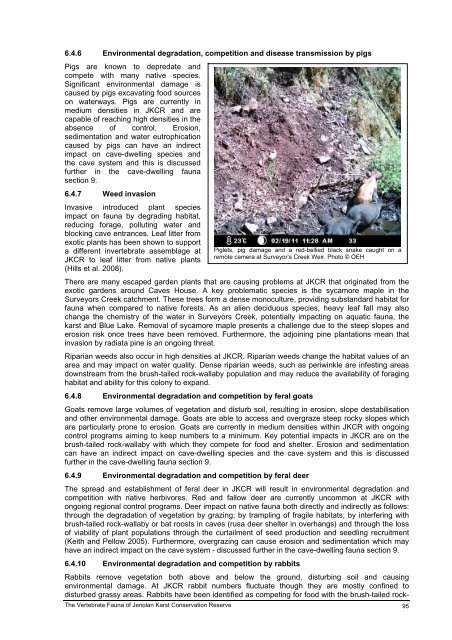The Vertebrate Fauna of Jenolan Karst Conservation Reserve: Final
The Vertebrate Fauna of Jenolan Karst Conservation Reserve: Final
The Vertebrate Fauna of Jenolan Karst Conservation Reserve: Final
Create successful ePaper yourself
Turn your PDF publications into a flip-book with our unique Google optimized e-Paper software.
6.4.6 Environmental degradation, competition and disease transmission by pigs<br />
Pigs are known to depredate and<br />
compete with many native species.<br />
Significant environmental damage is<br />
caused by pigs excavating food sources<br />
on waterways. Pigs are currently in<br />
medium densities in JKCR and are<br />
capable <strong>of</strong> reaching high densities in the<br />
absence <strong>of</strong> control. Erosion,<br />
sedimentation and water eutrophication<br />
caused by pigs can have an indirect<br />
impact on cave-dwelling species and<br />
the cave system and this is discussed<br />
further in the cave-dwelling fauna<br />
section 9.<br />
6.4.7 Weed invasion<br />
Invasive introduced plant species<br />
impact on fauna by degrading habitat,<br />
reducing forage, polluting water and<br />
blocking cave entrances. Leaf litter from<br />
exotic plants has been shown to support<br />
a different invertebrate assemblage at<br />
JKCR to leaf litter from native plants<br />
(Hills et al. 2008).<br />
Piglets, pig damage and a red-bellied black snake caught on a<br />
remote camera at Surveyor’s Creek Weir. Photo © OEH<br />
<strong>The</strong>re are many escaped garden plants that are causing problems at JKCR that originated from the<br />
exotic gardens around Caves House. A key problematic species is the sycamore maple in the<br />
Surveyors Creek catchment. <strong>The</strong>se trees form a dense monoculture, providing substandard habitat for<br />
fauna when compared to native forests. As an alien deciduous species, heavy leaf fall may also<br />
change the chemistry <strong>of</strong> the water in Surveyors Creek, potentially impacting on aquatic fauna, the<br />
karst and Blue Lake. Removal <strong>of</strong> sycamore maple presents a challenge due to the steep slopes and<br />
erosion risk once trees have been removed. Furthermore, the adjoining pine plantations mean that<br />
invasion by radiata pine is an ongoing threat.<br />
Riparian weeds also occur in high densities at JKCR. Riparian weeds change the habitat values <strong>of</strong> an<br />
area and may impact on water quality. Dense riparian weeds, such as periwinkle are infesting areas<br />
downstream from the brush-tailed rock-wallaby population and may reduce the availability <strong>of</strong> foraging<br />
habitat and ability for this colony to expand.<br />
6.4.8 Environmental degradation and competition by feral goats<br />
Goats remove large volumes <strong>of</strong> vegetation and disturb soil, resulting in erosion, slope destabilisation<br />
and other environmental damage. Goats are able to access and overgraze steep rocky slopes which<br />
are particularly prone to erosion. Goats are currently in medium densities within JKCR with ongoing<br />
control programs aiming to keep numbers to a minimum. Key potential impacts in JKCR are on the<br />
brush-tailed rock-wallaby with which they compete for food and shelter. Erosion and sedimentation<br />
can have an indirect impact on cave-dwelling species and the cave system and this is discussed<br />
further in the cave-dwelling fauna section 9.<br />
6.4.9 Environmental degradation and competition by feral deer<br />
<strong>The</strong> spread and establishment <strong>of</strong> feral deer in JKCR will result in environmental degradation and<br />
competition with native herbivores. Red and fallow deer are currently uncommon at JKCR with<br />
ongoing regional control programs. Deer impact on native fauna both directly and indirectly as follows:<br />
through the degradation <strong>of</strong> vegetation by grazing; by trampling <strong>of</strong> fragile habitats; by interfering with<br />
brush-tailed rock-wallaby or bat roosts in caves (rusa deer shelter in overhangs) and through the loss<br />
<strong>of</strong> viability <strong>of</strong> plant populations through the curtailment <strong>of</strong> seed production and seedling recruitment<br />
(Keith and Pellow 2005). Furthermore, overgrazing can cause erosion and sedimentation which may<br />
have an indirect impact on the cave system - discussed further in the cave-dwelling fauna section 9.<br />
6.4.10 Environmental degradation and competition by rabbits<br />
Rabbits remove vegetation both above and below the ground, disturbing soil and causing<br />
environmental damage. At JKCR rabbit numbers fluctuate though they are mostly confined to<br />
disturbed grassy areas. Rabbits have been identified as competing for food with the brush-tailed rock-<br />
<strong>The</strong> <strong>Vertebrate</strong> <strong>Fauna</strong> <strong>of</strong> <strong>Jenolan</strong> <strong>Karst</strong> <strong>Conservation</strong> <strong>Reserve</strong> 95

















